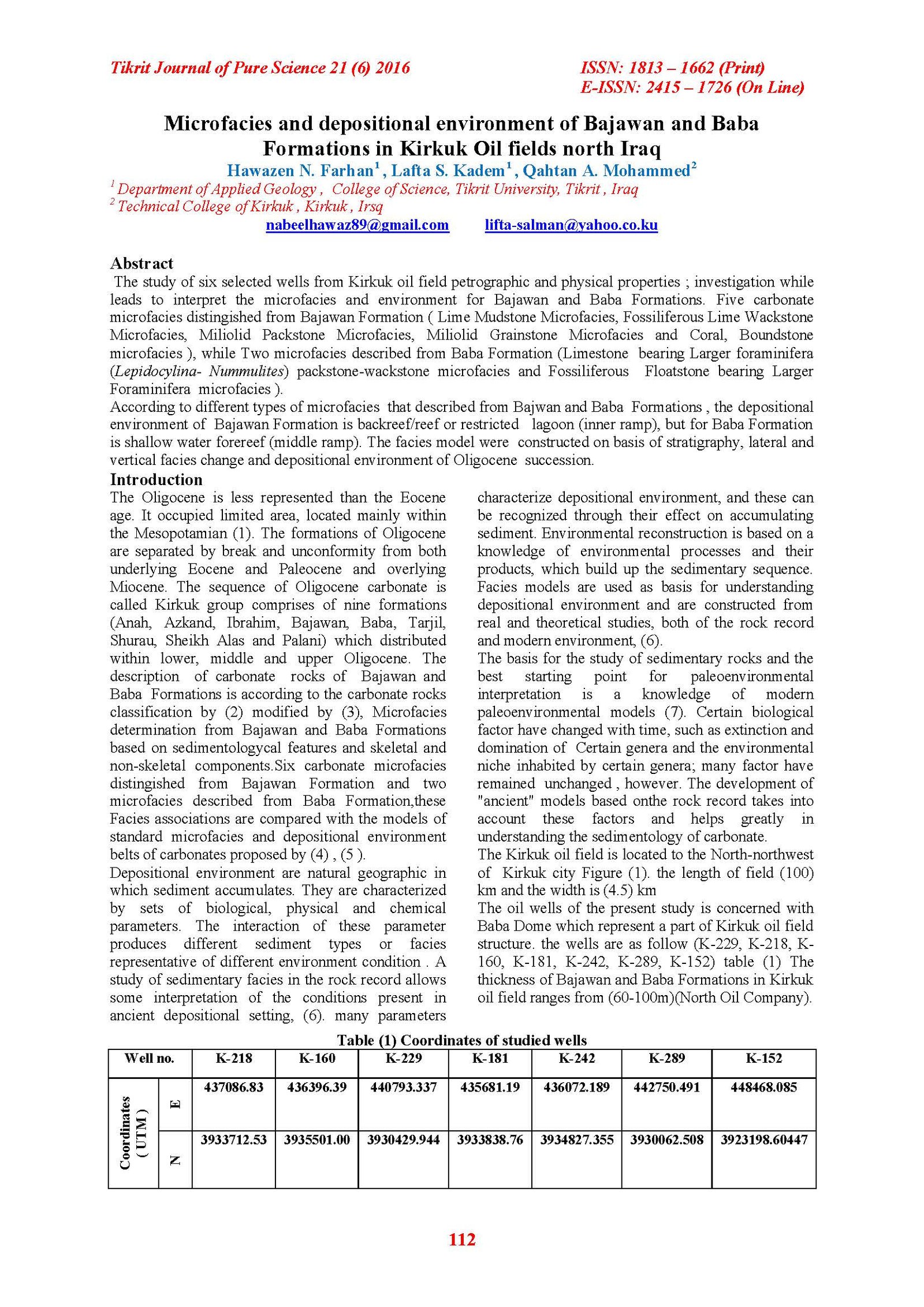Microfacies and depositional environment of Bajawan and Baba Formations in Kirkuk Oil fields north Iraq
Main Article Content
Abstract
The study of six selected wells from Kirkuk oil field petrographic and physical properties ; investigation while leads to interpret the microfacies and environment for Bajawan and Baba Formations. Five carbonate microfacies distingished from Bajawan Formation ( Lime Mudstone Microfacies, Fossiliferous Lime Wackstone Microfacies, Miliolid Packstone Microfacies, Miliolid Grainstone Microfacies and Coral, Boundstone microfacies ), while Two microfacies described from Baba Formation (Limestone bearing Larger foraminifera (Lepidocylina- Nummulites) packstone-wackstone microfacies and Fossiliferous Floatstone bearing Larger Foraminifera microfacies ).
According to different types of microfacies that described from Bajwan and Baba Formations , the depositional environment of Bajawan Formation is backreef/reef or restricted lagoon (inner ramp), but for Baba Formation is shallow water forereef (middle ramp). The facies model were constructed on basis of stratigraphy, lateral and vertical facies change and depositional environment of Oligocene succession.
Article Details

This work is licensed under a Creative Commons Attribution 4.0 International License.
Tikrit Journal of Pure Science is licensed under the Creative Commons Attribution 4.0 International License, which allows users to copy, create extracts, abstracts, and new works from the article, alter and revise the article, and make commercial use of the article (including reuse and/or resale of the article by commercial entities), provided the user gives appropriate credit (with a link to the formal publication through the relevant DOI), provides a link to the license, indicates if changes were made, and the licensor is not represented as endorsing the use made of the work. The authors hold the copyright for their published work on the Tikrit J. Pure Sci. website, while Tikrit J. Pure Sci. is responsible for appreciate citation of their work, which is released under CC-BY-4.0, enabling the unrestricted use, distribution, and reproduction of an article in any medium, provided that the original work is properly cited.
References
1 Jassim, S. Z., Karim, S. A., Basi, M., Al-Mubarak, M. A., Munir, J.,1984. Final report on the regional geological survey of Iraq, Volume 3,Stratigraphy. Manuscript report, Geological Survey of Iraq.
2 Dunham, R. J., (1962). Classification of carbonate rocks according to depositional texture. In: Ham, W. E., (eds.), Classification of carbonate rocks, , AAPG., Mem.1, PP. 108-121.
3 Embry, A.F., and Klovan, E.J., 1972. A Late Devonian reef tract in North Eastern Banks Island. North West Territories. Can Petrol. Geology Bull.vol.19, pp. 730-781 .,
4 Wilson JL (1975). Carbonate Facies in Geological History. Berlin-Heidelberg. New york: Springer. Pp471. Flügel E (1982). Microfacies analysis of limestones. Berlin - Heidelberg New York, Springer. 633p
5 Flügel, E. 2004. Microfacies of carbonate rocks: analysis, interpretation
and application, Springer Verlag. 984p.
6 Elf-Aquitaine., 1982. Paleoecological conditions andmorphological variation in monospecific banks of Nummulites: anexample. Bulletin des Centres de Recherches Exploration Production Memoire, 6, 557-563.
7 Heckle, P.H., 1983. Diagenetic Models Pennsylvania, Custatic Cyclo-thems, Jou. of Sed.. Pet.V.53,No.3,PP.733-789.
8 Jassim, S. Z., Goff, J. C., 2006. Geology of Iraq. Dolin. 341pp
9 Henson, F. R. S., 1950a. Cretaceous and Tertiary reef formations and associated sediments in Middle East. American Association of Petroleum Geology Bulletin, 34, 215–238..
10 Bellen, R. C. Van., (1956): the stratigraphy of the main limestone of Kirkuk, Bai-Hassan and Qarah Chauq Dagh structures in northern Iraq. Inst. Petroleum found. Vol. 42, London.
11 Majid, A. H., Veizer, J. A. N., 1986. Deposition and Chemical Diagenesis of Tertiary Carbonates, Kirkuk Oil Field, Iraq. AAPG Bulletin, 70, 898-913.
12 Amirshahkarami, M., Vaziri-Moghaddam, H., Taheri, A. 2007.Sedimentary facies and sequence stratigraphy of the Asmari Formationat Chaman-Bolbol, Zagros Basin, Iran. Journal of Asian EarthSciences, 29, 947-959.
13 Amirshahkarami M, Ghabeishavi A, Rahmani A (2010). Biostratigraphy and paleoenvironment of the larger benthic foraminifera in wells sections of the Asmari Formation from the Rag-e-Safid oil field (Zagros Basin, southwest Iran). Stratigraphy and Sedimentology Researches. 40(3): 63-84
14 Geel T (2000). Recognition of stratigraphic sequence in carbonate platform and slope: empirical models based on microfacies analysis of Paloogene deposits in southeastern Spain.
Palaeogeog. Palaeoclimatol. Palaeoecol. 155: 211–238.
15 Buxton MWN, Pedley HM (1989). A standardized model for Tethyan
tertiary carbonate ramps. J Geol Soc. Lond. 146: 746–748.
16 Yazdani R. (2014). Biostratigraphy and Facies Distribution of The Asmari Formation in Aghajari Well # 66, Zagros Basin, SW Iran. Int. Res. J. Geo. Min. 4(4): 101-115
17 Romero J, Caus E, Rossel J (2002). A model for the paleoenvironmental distribution of larger foraminifera based on late Middle Eocene deposits on the margin of the south Pyrenean basin (NE Spain). Palaeogeogr. Palaeoclimatol. Palaeoecol. 179: 43–56.
18 Tucker, M. E., Wright, V. P., Dickson, J., 1990. Carbonate sedimentology. An introduction, Vol. 3, Black well scientific publ.Oxford, 252p.
19 Hottinger, L., 1983, Processes determining the distribution of larger foraminifera in space and time: Utrecht Micropaleont. Bull. 30, p. 239-253.
20 Leutenegger, S., 1984, Symbiosis in benthic foraminifera, specificity and host adaptations:Journal of Foraminifera Research, no.14, p.16-35.
21 Hallock, P., and E.C., Glenn, 1999, Larger foraminifera: A Tool for Paleoenvironmental Analysis of Cenozoic carbonate depositional facies: Palaios, no.1, p. 55-64.
22 Reiss, Z., and L., Hottinger, 1984, The Gulf of Aqaba: Ecological Micropaleontology: Berlin –Springer. 354p.
23 Randazzo, A.G. and Zachos, L.G., 1984. classification and description of dolomitic fabric of rock from the Florida Aquifer, U.S.A.: Jour. Sed. Geii., vol. 37, No.3, pp.151-162.
24 Al-Qayim, B., 2006. Sag-Interior Oligocene Basin of North-central Iraq:Sequence Stratigraphy and Basin Overview (abstract), Middle EastConference and Exhibition; Manama, Bahrain.
